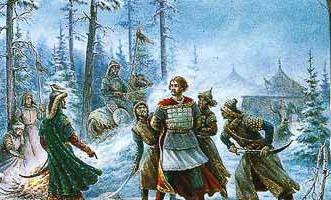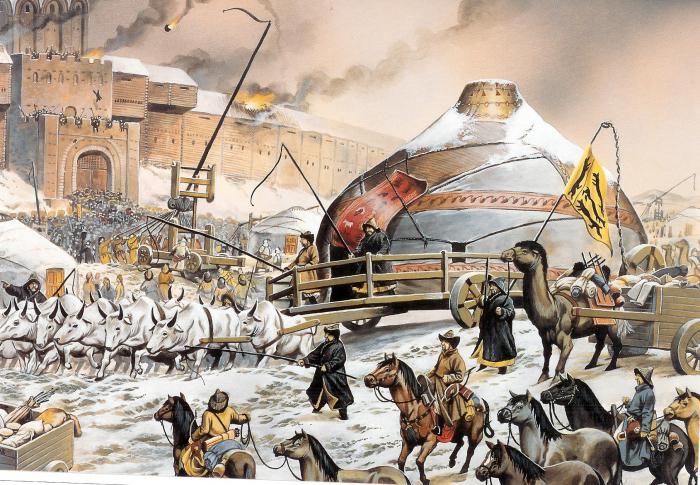In the history of every nation there are periods of the highest prosperity and times of decline. In Russia it was the same. Having reached the golden age under Vladimir the Great, Yaroslav the Wise and Vladimir Monomakh, the country was bogged down in internecine wars for the Kiev throne. There were too many princes, but there were still few thrones. So sons and grandchildren fought among themselves, with their brothers and uncles, and the state only lost from this. It is not surprising that Batu’s campaigns in Russia, which fell just at that time, were so successful. There was not only unity between the principalities, but also their desire to help each other. The cities weakened: the fortress walls were not in the best condition, there was a catastrophic lack of money, and there were not enough professional warriors. So ordinary townspeople had to defend their homes, those who never held weapons in their hands, and they simply did not have knowledge of military strategy and tactics.

Other reasons for the defeat of Russia
It is worth noting that there were other reasons for the defeat of Russia. Batu’s campaigns in Russia were not carried out spontaneously, they were carefully prepared and thought out. Ever since the time of Genghis Khan, the legendary commander from the depths of Asia, scouts said that the Russian principalities are very rich, and it will be quite easy to take them. As reconnaissance in battle, it is customary to consider a campaign that ended in a battle on the Kalka River. It is worth noting that the Mongol-Tatar army was very strong, and iron discipline and obedience to any order of the military leader contributed to success. In addition, having captured China, the Horde had at their disposal advanced military technologies and siege equipment, which had no analogues at that time.
Mongol invasion (briefly)
It is worth noting that there were two periods of the Mongol invasion. The first campaign of Batu to Russia lasted from 1237 to 1238. During his Horde conquered the Ryazan and Vladimir-Suzdal principalities, turned to Veliky Novgorod, but did not reach it and turned back. Before this, they captured the Volga Bulgaria. The second campaign of Batu to Russia can be briefly described as follows: during the period 1239-1240 he captured Kiev, the Vladimir-Volyn principality and went further to Europe. However, the Mongol-Tatars counted on a big quick victory, but the resistance turned out to be desperate. Having lost much power, the khan could not reach the last western sea, as he had intended before, so he turned back.
The conquest of Northern Russia. The capture of Ryazan
The first campaign of Batu to Russia was like a bolt from the blue. Of course, the Russian warriors remembered the battle on Kalka, knew that the Mongols were a dangerous opponent, but still they hoped that they would overcome him if he dared to come to them. The death of Genghis Khan pushed the start of a large military campaign, but this made it possible to build up strength. The sons of the commander conquered Northern China, the Volga Bulgaria, annexed to the army of the Polovtsy (Kipchaks). In December 1237, the horde, breaking the Volga, came right up to the border of the Ryazan principality. Batu demanded submission and tribute, but received a sharp answer. Ryazans asked for help from other Russian princes, but did not receive it. After five days of severe siege, the capital fell and was wiped off the face of the earth. The same fate befell Ryazan lands.
The ruin of the Principality of Vladimir. Battle of the Sit River
But the campaign of Khan Batu to Russia continued. The army moved to the Principality of Vladimir. Prince Yuri Vsevolodovich sent a squad under Kolomna, where she died. After Kolomna, Moscow, the capital city of Vladimir, fell. At the beginning of 1238, the regiments assembled by the prince were finally defeated on the River Sit. Further, a terrible rebuff to the Mongols was given by Torzhok, which stormed for two weeks, and Kozelsk, which they took after a seven-week siege. Fearing that soon the snow would begin to melt, the khan ordered to turn back, not reaching the walls of Novgorod, only a hundred miles. Although, it should be noted, some historians believe that rich Novgorod paid off the Mongols, and therefore was not taken. And there is also a version that Baty and Alexander Nevsky are one and the same person. And since Novgorod was his city, he did not ruin it.
Whatever it was, but on this the first campaign of Khan Batu to Russia ended. The horde retreated to Polovtsian lands to lick their wounds and gather strength for a new attack.
The second invasion of the Mongols
In the spring of 1239, Batu began a campaign in southern Russia. In March, Pereyaslavl was taken by the Mongol-Tatars, in October - the city of Chernihiv. After him, in 1240, the Horde besieged Kiev, the main city of Russia, its capital. Then Batu moved west, where he captured the Principality of Galicia-Volyn, invaded Poland and Hungary, and went to the shores of the Adriatic Sea. Perhaps the second campaign of Batu in Russia would not have ended, but news came of the death of the kagan. Wanting to take part in the kurultai, where they were to choose the new ruler of the Mongols, the grandson of Genghis Khan turned back to the steppe. The horde was no longer able to gather strength again for such a large-scale military campaign. Therefore, Europe remained untouched, Russia took a brutal blow and severely exhausted the enemy.
The capture of Kiev
Batu’s campaign in Russia cannot be briefly described. Each city resisted as best it could, but the forces were unequal. The chronicles describe the heroic rebuff of the Russians, who fought to the last drop of blood. This is what ancient sources say about taking Golden-Domed Kiev .

At that time, the city belonged to Daniil Galitsky, but the prince himself was not in it. The commander was commanded by the voivode Dmitry. As always, Batu demanded submission and tribute, promising pardon to all the defenders, but Kiev refused and rebuffed the invaders. Using powerful wall-hung guns, the Mongols entered the city, forcing the inhabitants away. The last defenders gathered at Detinets, building a new wall for defense. But that line was taken. Kievans gathered in the Church of the Tithes, which also collapsed, becoming a gravestone for patriots. The wounded, barely alive governor was brought to the khan, and Batu pardoned him for heroism. Such mercy has been widely used by the Mongols since the time of Genghis Khan. Later, Dmitry took part in horde campaigns in Europe.
Campaign Implications
Batu’s campaigns in Russia, both the first and the second, brought much grief to these lands. The principalities were ravaged, burned, the population was either killed or stolen. Of the cities, of which 74, 49 were destroyed. Fourteen of them could not rebuild and return to life. During the invasion, knowledge was lost, so stone construction, the production of glassware and window panes, cloisonne enamel ceased . A large number of princes and the ruling elite, warriors perished, the influence of the unprivileged sections of society increased. In Russia, economic decline, cultural and political degradation began, which dragged on for many years.
Riddles of history
But there is another view of history, another assessment of those events. Of course, Batu’s campaigns in Russia brought nothing good to her. However, many researchers believe that the Mongols were not as cruel as the chroniclers describe them. Of course, they are children of their time, which means they were forced to fight for survival in the ways that were available to them. Question the number of invaders. If Batu and the other princes brought a multimillion-strong army, then the horses would simply not have enough feed. Another mystery is why the small towns (Kolomna, Torzhok, Kozelsk) managed to hold the siege for a long time, while the capitals of the principalities with their massive walls were taken in a few days. And why did the nomads from the east need these small settlements that have no strategic significance? Why, after all, did the Mongols turn from Novgorod, whose riches were legendary? Why didn’t we go to Smolensk? Are you scared? But they were not from a timid dozen! But these questions remain unanswered to this day.